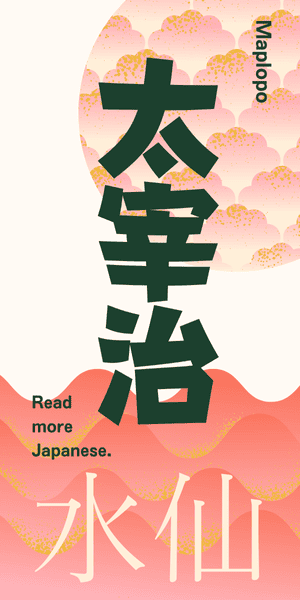Maplopo Program Tour
Intermediate Japanese Learning with Dazai Osamu
Complimentary Japanese Reading Lessons
Season ONE—水仙 (Page SEVEN)
EP.7 Spotlight: ~ている, Dazai Osamu (太宰治), Daffodil (水仙)
Video file / Audio File / Online Intermediate Japanese Course
~ている, EP.7 transcript | Intermediate and Advanced Japanese
In this lesson, we’re gonna take a look at the supporting verb, ている.
We’ll cover a number of these little magic makers in the course as they lend a lotta’ color and nuance to Japanese. Supporting verbs are… magical. They ENLIVEN words. They breathe meaning into sentences, lend nuance… create a certain sense… they are critical to the language, and critical to understand well as we work toward fluency. We’ll also cover a number of auxiliaries… after all, both tend to work very much hand-in-hand… so-to-speak.
Supporting verbs can appear be a bit unwieldy. But, they’re really quite simple. There is a logic to them… a… beauty, almost. And when we get an understanding as to how all these sinewy parts work in harmony to keep the language moving…, when we learn how things are built, and not just how they ARE…, that’s when we can finally start to lay down a nice bit of mortar that really gets things to stick.
So, let’s get to stickin’.
ている.
About as useful a supporting verb as they get. It’s everywhere. And, given how common it is, it’s no surprise it shows up this early in the story. But before we dive into ている itself…, let’s take a quick sidestep and talk some philosophy.
Philosophy?
Well, with that little いる in there we are, in fact, talking about “existence,” right? It’ll take just a bit…, and it’ll provide you with a view of supporting verbs you can carry with you forever. You’ll be able to classify your choices almost on a dime when you think about conjugation, you’ll be free of the need for memorization hacks, and you’ll walk away with an understanding of the one thing supporting verbs actually do for a main verb… and that one thing isn’t just “providing support.”
We’ll talk about two simple things.
Things that are concrete, and things that are abstract.
Ready?
Let’s start firmly on the ground with things that are concrete.
Okay.
So, things that are concrete are…, for one: REAL.
They’re actual, specific things or instances… …things that exist in reality or in real experience. They’re perceptible, and substantial… And, most importantly, they’re not abstractions. …meaning…, they are not ideas.
In contrast…
Things that are abstract ARE ideas.
They’re disassociated from any specific instance…, They’re impersonal and detached… They’re entirely immaterial. Things that are abstract are conceptual or non-specific. They are in fact, IDEAS…. qualities…We cannot touch, see, smell, hear or taste things that are abstract. But we CAN do all of that with things that are concrete.
Okay. So, what in the heck does this have to do with supporting verbs?
Well, in a word, everything.
Because in general, Japanese verbs that stand solo… (without the adornment of a supporting verb or an auxiliary)… tend to lean toward being abstract. Or, they connote the future. This means they do not allow us the ability to talk about a current state… that they cannot be understood as referring to anything that is happening now…, to nothing related to a current or present moment. Knowing this can help us cut through a lot of guesswork when it comes to understanding the intention of even the shortest passage, and can help us build better sentences in Japanese.
For a nice cut and dry way to see this, let’s consider the verbs 生きる and 死ぬ. When these verbs stand alone… without the assistance of a helping verb, they remain in their purest form… they are conceptual (abstract)… they express the idea of life, the idea of death.
When we attach ている to each, however, the verb gains access to the real world… it gains a certain sense of reality… something we can experience…, and something with more specificity to it. We’re now given the ability to talk about being alive, or about someone who has died—we’re given the opportunity to create real, concrete meaning… not simply discuss the concept of life and living, like the famous Kurosawa movie, 生きる, but of actually being alive.
Okay.
So how about this idea of unadorned verbs leaning toward the future? How do we know that’s what we’re dealing with? Well, context, of course, tells many-a-story, and that’s true here as well. Let’s take this sentence for example:
(Speaking in Japanese )
So, we’re expressing the future here, right? We’re going to go home. We wouldn’t be inclined to think this is a verb leaning toward abstraction, but we do know this sentence is NOT talking about the present without a supporting verb attached.
Same here:
(Speaking Japanese)
はしる sans a supporting verb is expressing a future thing. There should be no question that this is a future oriented action verb.
Cool? Okay, so, that should help with listening, speaking, reading and writing. In a nutshell: in most cases, a verb needs a supporting verb to refer to anything related to a present moment. And, this hereby ends the philosophy portion of this lesson. That’s the why of supporting verbs…
Let’s have a look at ている itself.

